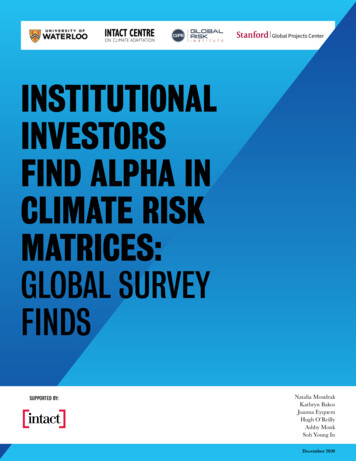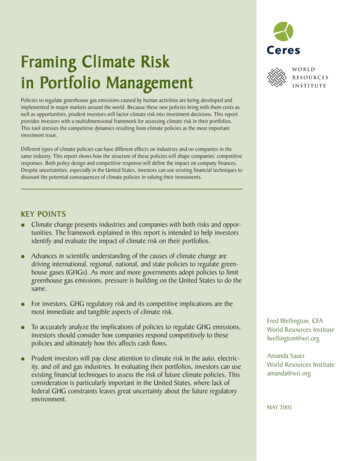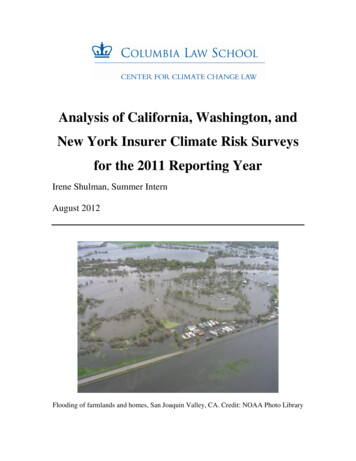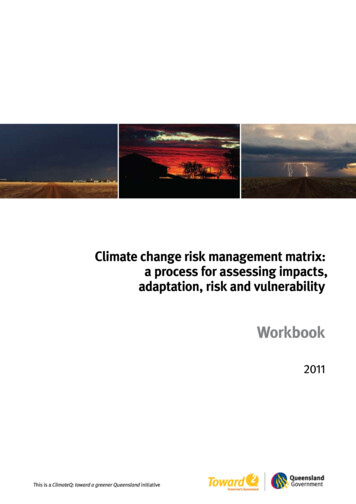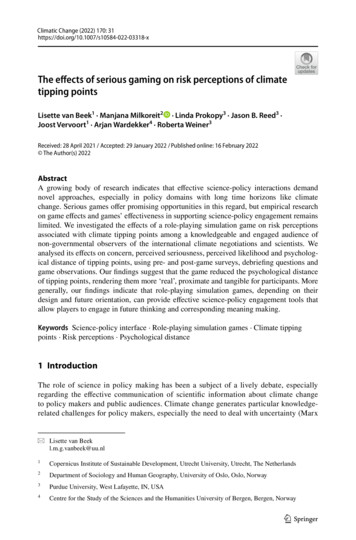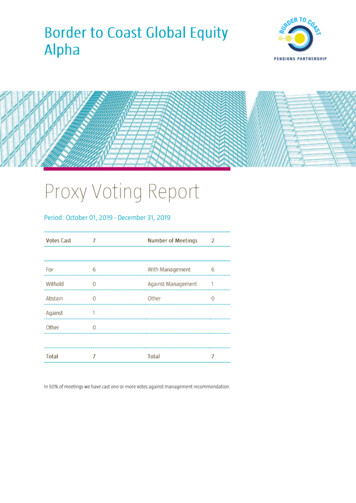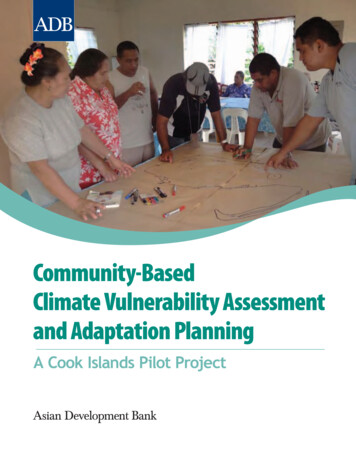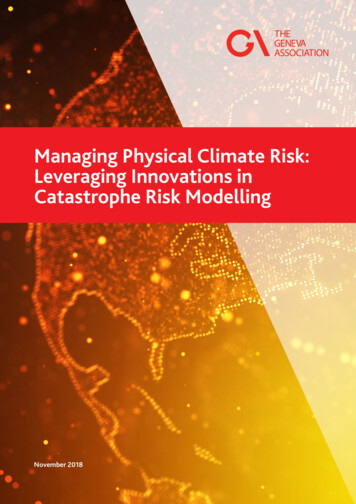
Transcription
November 2018
MANAGING PHYSICAL CLIMATE RISK: LEVERAGING INNOVATIONS IN CATASTROPHE RISK MODELLINGThe Geneva AssociationThe Geneva Association is the leading international insurance think tank for strategically important insurance and riskmanagement issues. The Geneva Association identifies fundamental trends and strategic issues where insurance playsa substantial role or which influence the insurance sector. Through the development of research programmes, regularpublications and the organisation of international meetings, The Geneva Association serves as a catalyst for progress inthe understanding of risk and insurance matters and acts as an information creator and disseminator. It is the leadingvoice of the largest insurance groups worldwide in the dialogue with international institutions. In parallel, it advances—in economic and cultural terms—the development and application of risk management and the understanding ofuncertainty in the modern economy.The Geneva Association membership comprises a statutory maximum of 90 chief executive officers (CEOs) from theworld’s top insurance and reinsurance companies. It organises international expert networks and manages discussionplatforms for senior insurance executives and specialists as well as policymakers, regulators and multilateralorganisations.Established in 1973, The Geneva Association, officially the ‘International Association for the Study of InsuranceEconomics’, is based in Zurich, Switzerland and is a non-profit organisation funded by its Members.www.genevaassociation.org@TheGenevaAssoc
Managing Physical Climate Risk:Leveraging Innovations inCatastrophe Risk ModellingMaryam Golnaraghi - Director Extreme Events and Climate Risk, The Geneva Association (lead and coordinating author)Paul Nunn - SCOR SERobert Muir-Wood - Risk Management SolutionsJayanta Guin - AIR WorldwideDickie Whitaker - OASIS Loss Modelling FrameworkJulia Slingo - Former Chief Scientist of UK Met officeGhassem Asrar - Pacific Northwest National LaboratoryIan Branagan - Renaissance Re and Insurance Development Forum’s Working Group on Risk Modelling and MappingGerry Lemcke - Swiss ReClaire Souch - AWHA ConsultingMichel Jean - Canadian Centre for Meteorological and Environmental Prediction and the World MeteorologicalOrganization’s Commission for Basic SystemsAlexandre Allmann - Munich ReMolly Jahn - University of WisconsinDavid N. Bresch - Institute for Environmental Decisions at ETH, and MeteoSwissPatrick Khalil - Intact Financial CorporationMichael Beck - The Nature Conservancy and University of California Santa CruzManaging Physical Climate Risk: Leveraging Innovations in Catastrophe Risk Modelling1
MANAGING PHYSICAL CLIMATE RISK: LEVERAGING INNOVATIONS IN CATASTROPHE RISK MODELLINGThe Geneva AssociationTalstrasse 70, CH-8001 Zurich Tel: 41 44 200 49 00 Fax: 41 44 200 49 iation.orgPhoto credits:Cover page—ShutterstockNovember 2018Managing Physical Climate Risk: Leveraging Innovations in Catastrophe Risk Modelling The Geneva AssociationPublished by The Geneva Association—International Association for the Study of Insurance c
ContentsAcknowledgements4Foreword5Executive summary71. Context102. Evolution of Cat risk modelling since the 1980s123. Considerations for development and utilisation of Cat models214. Opportunities for expanding Cat models for shaping the future of disaster and climate risk management275. Harnessing latest scientific and technological developments to innovate Cat modelling326. Recommendations for the way forward36References39Glossary43Managing Physical Climate Risk: Leveraging Innovations in Catastrophe Risk Modelling3
AcknowledgementsIn preparing this report, we benefited from discussions that engaged over 130 leading international experts convened atThe Geneva Association’s 2017 Extreme Events and Climate Risk Forum, co-organised by SCOR Foundation and hostedby SCOR SE in Paris. Furthermore, we are grateful to Kerry Emanuel (MIT), Jim Abraham, Madeleine Thomson (ColumbiaUniversity), Jianming Yin, Lawrence Buja (National Center for Atmospheric Research) and Licelotte Carvajal Jimenez fortheir contributions. We would like to thank members of The Geneva Association’s Extreme Events and Climate RiskWorking Group, including Moya Chew Lai (Prudential), Martin Beaulieu (Intact), Liesbeth van der Kruit (Achmea), Luc deLignieres (AXA), Paulina Murphy (Aviva), Lucy Stanbrough (Lloyd's), Masaaki Nagamura (Tokio Marine), Fielding NortonIII (XL Catlin), Ernst Rauch (Munich Re), Tobias Grimm (Munich Re) and Eva Lösch (Munich Re), Simone Ruiz Vergote(Allianz), Joachim Schroeter (Allianz Re), John Scott (Zurich), Jörg Steffensen (Hannover Re), Thomas Weist (TokioMarine) and Martin Weymann (Swiss Re). We also extend our thanks to Guillaume Ominetti (SCOR SE), Kei Kato (TokioMarine) and Panos Charissiadis (Munich Re) for their review of the final report.4www.genevaassociation.org@TheGenevaAssoc
ForewordThere was a time when catastrophe risk modelling was prepared on a spreadsheet—one pereach peril, perhaps. The insurance industry has been instrumental in the evolution of thisfield. From its humble beginnings the so-called Cat modelling has evolved into a complex,rigorous, multi-layered discipline that has revolutionised the way insurance companiesassess, price, underwrite and put in place efforts to mitigate catastrophe risk.Anna Maria D’HulsterSecretary General,The Geneva AssociationCat modelling is more relevant than ever. By some estimates, total global economic lossesfrom natural disasters and man-made catastrophes in 2017 were USD 337 billion, andglobal insured losses from disaster events in 2017 were USD 144 billion. Just to put it inperspective, hurricanes Harvey, Irma and Maria resulted in combined insured losses ofUSD 92 billion, equal to 0.5% of U.S. GDP.The question is: are Cat models broad and detailed enough to assist insurers andpolicymakers fully grasp the costs and implications of catastrophe risk? In a world withnatural phenomena so complicated and affected by climate patterns so erratic, what is thepredictive power of the insurance industry’s Cat modelling capabilities?The conditions are ripe for the next generation of Cat models. The insurance industry, withis extensive experience in catastrophe risk modelling, can make a significant contribution.It is imperative to bring together different fields of science to ensure that Cat models widentheir scope and address the unprecedented complexity of natural and man-made disastersand the interconnections between them.The usefulness of Cat models to the insurance industry and wider society could be evenfurther enhanced by integrating the latest climate science and a variety of technologiesinto the modelling framework. This requires an in-depth understanding of the fundamentalassumptions, intended model usage, and model limitations. The incorporation of data fromadvanced hazard simulations or innovative engineering perspectives on physical damage,just to name two examples, would go a long way in reinforcing the value proposition ofCat models. A collective endeavour across insurers, the scientific community and modelvendors is necessary, not only to benefit further from the current modelling framework butalso to extend the Cat models' capabilities.While Cat modelling is not the panacea to catastrophe risk, it is unlikely that extremeNatcat losses recorded in 2017 will be a one-off event. As the effects of climate changebecome more severe, the insurance industry must keep up with market demand andanticipate future changes through the advancement of risk analytics.Few sectors of the economy play a role as intense in catastrophe recovery as insurance.Individuals, families, communities and governments rely on the sector’s capacity to providefinancial relief in the form of claims. What is at stake is not only the stability of the industrybut also society’s resilience to catastrophe risk.Managing Physical Climate Risk: Leveraging Innovations in Catastrophe Risk Modelling5
Key messages1) For the past several decades, Cat models have served the (re)insurance industry well, facilitating strong riskanalysis and management culture as well as portfolio management practices of property risks throughout theindustry value chain.2) There is much more that could be done to extend the value of Cat models for the (re)insurance industry andwider society. This requires a collective endeavour across (re)insurers, brokers, model vendors and other keystakeholders to not only further benefit from the current Cat model framework, but also extend the Cat models’capabilities.3) The usefulness of Cat models to the (re)insurance industry and wider society could be even further enhancedwith new climate modelling and observational capabilities, as well as other emerging new technologies (e.g.supercomputers, cloud sourcing, deep learning, visualisation, engineering and materials science).4) There is an opportunity to extend the Cat loss model value proposition by addressing the Cat modelling relianceon historical data through integration of the latest climate science and modelling. This could support new climateinsurance products and service offerings as well as leveraging these forward-looking tools for integration ofphysical climate risk, into core business both now and for the future based on the recommendations of theFinancial Stability Board's Task Force on Climate-related Financial Disclosures (TSB-TFCD).5) In light of the large investment gap in infrastructure globally, expansion of Cat risk modelling to the infrastructureproject life cycle to assess risks of extreme weather/climate events could provide a great opportunity to de-riskthe projects, enhance climate resilience, offer risk transfer solutions and increase investment opportunities.6) Development efforts by practitioners should consider connecting Cat models to other systems-based models foreconomics analysis, food, energy and water management, and the provision of critical infrastructure and healthservices. This will lead to a better understanding and assessment of the impacts of feedback loops and cascadingeffects that can further aggravate disaster impacts, prolonging recovery and increasing costs.6www.genevaassociation.org@TheGenevaAssoc
Executive summaryOver the past 30 years, Catastrophe Loss Modelling—arguably the first InsurTech offering in the form of innovativetools (Cat models)— has transformed the (re)insuranceindustry’s capacity to assess, price and manage risk forproperty catastrophe business and has provided a sharedcommon language of risk for risk transfer.Today, Cat models are used across the world, addressinga growing suite of hazards for an increasing number ofcountries. Funded at hundreds of millions of U.S. dollarsby the (re)insurance industry, specialist firms of modelvendors have assembled an eclectic mix of technicaldisciplines1 to supply these multi-disciplinary toolsthat have helped (re)insurance companies manage thedownside risk from extreme events. The value of Catmodels has also been recognised across many othersectors and users, leading to various derivatives of thesemodels that are supported by development professionals,the financial sector and national to local governments, formaking risk-based decisions (Geneva Association 2016a-c;The Geneva Association and IDF 2017).The framing of climate risk under physical, liability andtransition risk has made it possible to quantify it andincorporate it into core business (Carney 2015; FSB-TCFD2017).2 For companies, issues are increasingly arounddevelopment of standard tools and methodologies,acquiring the expertise for analysing physical andtransition risk, and conducting stress testing for differentclimate scenarios (e.g. 1.5 /2 /3 /4 C) to properly pricethe risk and appropriately allocate capital to manage it.Since the release of the FSB-TCFD recommendations in2017, banks, asset managers and institutional investorsare increasingly considering assessing risks of extremeweather (physical risk) in their investment portfolios.Indeed, Cat models could play an important role incapturing physical risk of climate change. However,they need to be conditioned on rapidly advancingearth observations and climate change models tobetter understand the sensitivity of this risk to climate12change and the associated impacts that may result fromchanges in distributions of this risk for insurable assets.The resulting analysis can help companies from varioussectors (e.g. (re)insurance, banking, asset managers,energy) to understand the extent of their physical risk inrelation to their assets, operations, investments and riskmanagement practices.Recommendations for the way forwardRecommendation 1: Further leverage andenhance current Cat modelling methodologies and toolsTo some extent it can be said that models make markets. Inturn, markets are also needed to stimulate investment in thecurrent commercially driven catastrophe model paradigm.There is much more that could be done to extend thevalue of Cat models to the (re)insurance industry. Werecommend a call for action to (re)insurers, brokers, modelvendors, the development community and the publicsector in the following areas:(i) Drive for interoperability among Cat models;(ii) All stakeholder groups should scale up ambition forglobal coverage of natural peril models for everycountry, across high-, middle- and low-incomecountries;(iii) Extend existing models to address current limitationsand gaps, particularly: business interruption (BI) andcontingent business interruption (CBI) and supplychain modelling, economic demand surge, and lossadjustment expenses;(iv) Set expectations of transparency and uncertaintyquantification in model design and limitation, whileremaining sensitive to commercial considerationsaround investment in intellectual property;Geophysical scientists, various types of engineers, mathematicians, software engineers, actuaries and insurance professionalsClassification of climate risk (FSB-TCFD 2017):- Physical risk: Climate- and weather-related events impact on property, infrastructure, supply chains and trade (e.g. floods, storms) - Increasedseverity and frequency of extremes or long-term shifts in climatic patterns- Transition risk: Financial risks from transitioning towards a lower-carbon economy–Policy and legislative, technology and physical risks couldprompt asset-value reassessment (stranded assets)- Liability risk: Those who have suffered loss or damage from climate change seeking compensation from those they hold responsible - Potential tohit carbon extractors and emitters – and, if they have liability cover, their insurers – the hardestManaging Physical Climate Risk: Leveraging Innovations in Catastrophe Risk Modelling7
EXECUTIVE SUMMARY(v) Improve risk communication of model outputs andrelated model uncertainty among users;(vi) Agree on and develop a uniform international exposuredata standard to enable transparency, comparabilityand acceptance of results and allow for efficient use ofCat models.Recommendation 2: Embed latest climatescience in Cat models and explore opportunities forimproving modelling of physical climate risk with aforward-looking approach, taking into considerationthe climate change scenarios.While a highly complex issue, integration of latest climatescience, earth climate system simulations (synthetic data)and nested models within the Global Climate Models(GCMs) into Cat models could potentially be a gamechanger to develop Cat modelling towards a forwardlooking approach.Building on the international scientific cooperation inclimate science and modelling, this offers the opportunityto extend the Cat loss model value proposition to alsosupport new climate insurance product offerings, bothnow and for the future. Furthermore, such enhancedmodels linked to GCMs could be critical for integratingphysical climate risk into core business, financial systemsand investment applications (linking to FSB-TCFDrecommendations). Integration of such climate changecalibrated Cat risk models could potentially enable(re)insurers, other segments of the financial sectors,businesses, public sectors and other stakeholders tomanage the physical risk of climate change now and forthe future.8www.genevaassociation.orgCat models need conditioning to understand climatechange sensitivity and the associated impacts that mayresult from changes in risk distribution for insurable assets.Perils that would clearly benefit from such enhancementinclude: wildfire, large-scale hail, agricultural crop yields,drought, coastal surge flooding (via sea level rise),and extreme precipitation like cloudburst and evensnowmageddon type events. With advancements in theunderstanding of climatic regimes and interconnectivitiesin the weather patterns the inclusion of the correlationsbetween ‘independent’ peril regions within existing Catmodels may be considered.Recommendation 3: Consider ‘models of models’and embrace a systems-based thinking for developmentof the next generations of Cat risk modelsThe usefulness of Cat models to the (re)insuranceindustry and wider society could be even furtheradvanced if connections are made to models in otherdomains and fields of study. The overarching benefit ofcoupling models would be to better understand feedbackloops and cascading effects within and across sectors(e.g. water-energy-food nexus). Cat models, extendedto reflect climate-conditioned future scenarios, couldprovide new insights and support policy, planning anddecision-making.@TheGenevaAssoc
Cat models have transformed (re)insurance industry’s capacity to assess, price and manage risk for propertycatastrophe moduleAssessesthe level ofphysical hazardacross a regionconsideringfactors such asthe topography,soil type, landuse and built-inenvironmentEstimates of thelocation andevent responsecharacteristicsof exposure.Estimatesthe physicaldamage onthe asset atrisk, expressedin terms ofa certainpercentage lossof value to theexposure.Monetiseslosses ofthe physicaldamages;estimates ofinsured lossesare computedusing insurancepolicy termsand contractstructures.Summary example results of an EP analysisAnnual exceedance probability (EP), %Hazardmodule109876543210010203040506070Loss amount (USD millions)Expansion of Cat models by peril and geography hasbeen 'demand-led'PerilsBeyond (re)insurance, Cat models are used in a varietyof applications with potential for further expansion toother sectorsRegionsHurricaneEarthquakeExtratropical cycloneSevere thunderstormCoastal floodingInland floodAgriculture and wildfireSevere hailstormMan-made perilsLiquefactionTsunamiLandslideRainfall-induced floodingU.S.EuropeJapanCanadaAustraliaNew ZealandSouth AmericaThe CaribbeanSoutheast AsiaChinaIndiaSeven key factors drive the Cat models(Re)insurers inproperty/Cat business,development planningPublic-sector disasterrisk Financial andcapital marketsManaging naturalinfrastructureOur recommendationsData requirements,hazard, exposure andvulnerability1Further leverage and enhancecurrent Cat modellingmethodologies and toolsMethodologiesRegulatoryissuesOpen framework andopen source versusrestrictedStandards andinteroperabilityModel validationand uncertaintyestimation3Consider ‘models ofmodels’ and embrace asystems -based thinking fordevelopment of the nextgenerations of Cat modelsResourcerequirements2Embed latest climatescience in Cat models andexplore opportunities forimproving modelling of physicalclimate risk with a forwardlooking approach taking intoconsideration climatechange scenariosSource: The Geneva AssociationManaging Physical Climate Risk: Leveraging Innovations in Catastrophe Risk Modelling9
1. ContextOver the last three and a half decades, we haveobserved a trend of rising economic losses from extremeevents globally. Between 1980 and 2017, Munich Re’sNatCatSERVICE reported 17,320 disaster loss events.Of those, 91.2 per cent were caused by weatherrelated extremes (meteorological, hydrological andclimatological events), accounting for 49.2 per cent ofthe total of 1,723,738 lives lost, 79.8 per cent of the totalUSD 4,615 billion in reported economic losses and 90.1 percent of total insured losses of USD 1,269 bn.3In 2017, weather-related extremes accounted for 97 percent of total reported economic losses and 98.2 percentof total insured losses (Figure 1).4 A significant portion ofeconomic losses, particularly in the middle- and high-incomecountries, were caused by damages to infrastructure.Climate variability and change, along with socio-economicfactors such as population growth, construction practices,rising urbanisation and complex interconnected supplychains and trade patterns globally, further drive andexacerbate these impacts.These point to the growing demand for risk information,risk modelling and stress testing tools, expertise and datafor managing the impacts of weather-related extremesin both public and private sectors.5 The adoption of theSendai Framework for Disaster Risk Reduction (2015–2030), the 2030 Sustainable Development Summitand the COP21 Climate Change Paris Agreement havepromoted the need for a comprehensive and integratedapproach to managing risks and building socio-economicresilience to extreme events and climate change, involvingdifferent economic sectors and levels of government. As aresult, a complex landscape of stakeholders has emergedto promote and support the governments with thedevelopment of risk-based proactive policies, regulatorymeasures and development strategies in the public sector(The Geneva Association 2016a-b, 2017, 2018).However, the game changer for the financial markets andall publicly traded companies was the framing of economicimpacts of climate change under physical risk, liability riskand transition risk (Carney 2015).6Figure 1: Global weather-related loss events (1980–2017)Uninsured and insured losses with 5-year moving average Uninsured losses(in 2017 values) Insured losses(in 2017 values)5-year moving averageuninsured losses(in 2017 values)5-year moving averageinsured losses(in 2017 values)US bn40030020010001980 1982 1984 1986 1988 1990 1992 1994 1996 1998 2000 2002 2004 2006 2008 2010 2012 2014 2016Inflation-adjustedvia country-specificconsumer price index andconsideration of exchangerate fluctuations betweenlocal currency and USD.Source: Munich Re NatCatSERVICE345610Both are inflation-adjusted.Total economic losses associated with weather-related extremes reached USD 330 billion, with both reported insured and uninsured losses at arecord high.In fact, Sendai Framework’s first priority for action is ‘Understanding Disaster Risk’. Similarly, the Paris Agreement stresses the importance of riskinformed adaptation planning.Mark Carney, Governor of the Bank of England and Chairman of the G20’s Financial Stability Board, delivered his historical speech, ‘Breaking thetragedy of the horizon—climate change and financial stability’ at Lloyd’s of London on 29 September 2015.www.genevaassociation.org@TheGenevaAssoc
Subsequently, the industry-led FSB-TCFD has offeredrecommendations for publicly-traded companies fordisclosing comparable and consistent information aboutthe risks and opportunities presented by climate change.Pricing physical risk of climate change is an emergingcategory of risk for all sectors to support informed,efficient capital allocation decisions.The global insurance industry has been leading the wayin innovating and advancing Cat modelling since the late1980s, prompted by unprecedented insurance losses andcompany insolvencies in the 1980s and 1990s, owing tomajor catastrophes in the U.S. and Europe. Over the lastfew years, the (re)insurance industry has been workingclosely with the international community to transfer thesetechnologies for the public sector to areas such as disasterrisk management, development planning and sovereignrisk transfer in the middle-and low-income countries(The Geneva Association 2017). A few initiatives areunderway to explore the value proposition of the insurers’expertise and Cat modelling tools for assessing physicalrisk exposure in other parts of the financial system(ClimateWise 2018).Section 2 describes the evolution of Cat modellingsince the 1980s. In Section 3 we highlight challenges ofdeveloping and utilising Cat models. Section 4 outlines anumber of potential areas where expansion of Cat modelscould help with improving decision-making and riskmanagement practices. In Section 5 we highlight sometechnological developments that could be leveraged forimproving Cat modelling. Our recommendations for theway forward are provided in Section 6.In this report, we examine Cat modelling as a critical toolto help improve and even reshape the future of disasterand climate risk management. To this end, The GenevaAssociation has brought together leading internationalexperts from the commercial Cat risk modelling firms,the (re)insurance industry, the scientific community(specifically, operational weather and climate modelling)and academia to explore this issue and offer collectiveinsights for future consideration. This report has alsobeen informed by the 2017 Geneva Association Forumon Extreme Events and Climate Risks on ‘How Will RiskModelling Shape the Future of Risk Transfer?’ co-organisedwith the SCOR Foundation and hosted by SCOR SE in Paris.Managing Physical Climate Risk: Leveraging Innovations in Catastrophe Risk Modelling11
2. Evolution of Cat risk modelling sincethe 1980sCommercial catastrophe risk modelling tools emergedas the first InsurTech offering to transform the assessing,pricing and managing of the property catastrophe business.This followed a series of insolvencies, linked to a numberof major catastrophes in the U.S. and Europe in the 1980s.Over the past three and a half decades, Cat models haverevolutionised approaches to pricing, underwriting andmanaging property and catastrophe portfolios across theinsurance industry value chain.The origins of catastrophe risk modelling are rooted inthe fields of property insurance, structural engineeringand scientific research of ‘natural hazards’ (Friedman1975). Cat models have become ubiquitous tools formanaging large and unpredictable losses associated withnatural catastrophe risks across the insurance industryvalue chain (Figure 2). They are used to inform riskpricing and underwriting decisions, claims settlementprocesses, portfolio management, calculating solvency,and other regulatory, rating agency and economic capitalrequirements. Over the years, the (re)insurance industry’sreliance on Cat models has increased to the point that insome jurisdictions the regulators require the Cat modelsto be officially certified for use in markets.Widespread adoption of Cat models combined with anon-going feedback loop between users ((re)insurers)and providers (Cat model vendors) have contributed tomodel improvements and increasing expertise amongthe insurance industry users. Data and insights from pasthigh-impact natural catastrophes have helped to developthe Hazard and Vulnerability modules (Boxes 1 and 2)and incorporate additional loss sources in subsequentmodel releases.7 Real-world events have also revealed thelimitations of Cat models as well as the importance ofunderstanding the underlying assumptions and inherentuncertainty in model outputs. Cat model developershave in turn responded by educating the users aboutthe sources of model uncertainty and the importance ofsensitivity testing of model assumptions.Figure 2: The insurance industry value chainAggregate of mpaniesBacking assetsBrokersReinsuranceManaged internally or okers/agentsback-to-backbusinessLiabilitiesPooling of risksLife insurersLong-term obligationsExamples: Life and death benefits, pensions,annuities, unit-linked saving productsGeneral insurers(Non-life)Predominantly annual contractsExamples: Property cover, health insurance,coverage against miscellaneous financiallosses for individuals and companiesReinsurancecompaniesSecuritisationSell insuranceto insurers,enable insurancecompanies to cedecumulative risksFinancialmarketsExamples:Longevity riskbonds, cat bondsGovernmentsSource: The Geneva Association (2018)712Key high-impact catastrophes such as hurricane Andrew (1992), Northridge earthquake (1994), storms Lothar, Martin, and Anatol (1999),hurricane Katrina (2005), Tohoku earthquake (2011), Christchurch earthquake (2011), Bangkok floods (2011), and hurricane Sandy (2012) providedsubstantial data that was instrumental in improving the Cat models.www.genevaassociation.org@TheGenevaAssoc
Box 1: Components of a Cat model designed for (re)insurance applicationsCat models are built on four key components:- Hazard module: Assesses the level of physical hazard across a region, integrating factors such as the topography, soiltype, land use and interaction with the built environment. The stochastic event generation sub-module creates a catalogueof hypothetical events by simulating thousands of event footprints for each specified region-peril combination, typicallyparameterised on historical hazard data.- Exposure module: The proximity of properties or infrastructure to the hazard is what generates risk. Estimates thelocation and event response characteristics of exposure.- Vulnerability module: Estimates the physical damage to the asset at risk (e.g. various types of structures and theircontents).- Financial module: Monetises losses associated with the physical damage and estimates financial oduleAssessesthe level ofphysical hazardacross a regionconsideringfactors such asthe topography,soil type, landuse and built-inenvironmentEstima
Managing Physical Climate Risk: Leveraging Innovations in Catastrophe Risk Modelling 5 There was a time when catastrophe risk modelling was prepared on a spreadsheet—one per each peril, perhaps. The insurance industry has been instrumental in the evolution of this field.
